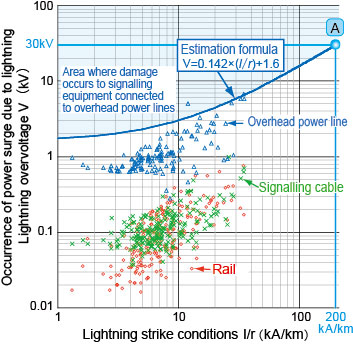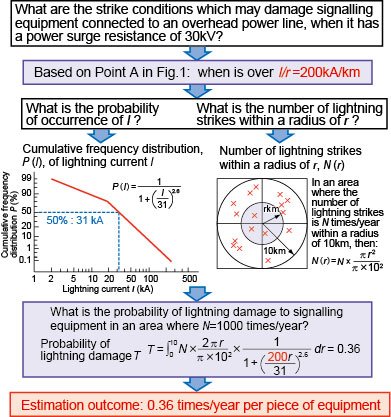10.Method for estimating the probability of lightning damage to signalling equipment considering lightning strike conditions
- A method has been developed for estimating the probability of lightning damage to signalling equipment.
- The estimation method can be employed to assist decisions on whether or not to introduce lightning protection measures to signalling equipment.
An important factor needed to decide whether lightning protection measures should be taken to protect signalling equipment is the lightning strike risk assessment which clarifies whether the measure will be effective or not in reducing damage. Nonetheless, today there is no quantitative method to determine the probability of lightning damage occurrence based on lightning current and distance to strike location.
Consequently, measurements were taken over a long period of time of the power surges caused by lightning strikes in signalling equipment ground signalling cables, overhead power line and rails. The correlation (l/r) was then sought between lightning current (l) and distance between the observation point and the strike location (r) (Fig.1).
Using the estimation formula in Figure 1, it is possible to identify which lightning strike conditions can provoke lightning damage to signalling equipment connected to overhead power lines, signalling cables and rails. For example, signalling equipment with a surge resistance of 30kV connected to an overhead power line is likely to suffer lightning damage if strike conditions exceed (l/r) 200 kA/km (Point A in Fig.1). Estimations were generally found to compare well with actual data on strike conditions which had caused lightning damage.
By considering probability of occurrence of lightning strike conditions, it is possible to estimate the probability of lightning damage to signalling equipment (Fig.2). For example, within a radius of 10km coupled with 1000 lightning strikes/year and signalling equipment in that area with a surge resistance of 30kV, it is possible to estimate that lightning damage will be 0.36 times/year per piece of equipment.
This method should help clarify which type of surge resistance should be installed on signalling equipment in order to reduce lightning risk to target levels.

Fig.1 Estimation of lightning strike conditions
which may lead to lightning damage
Fig.2 Example of calculation of probability of
lightning damage to signalling equipment